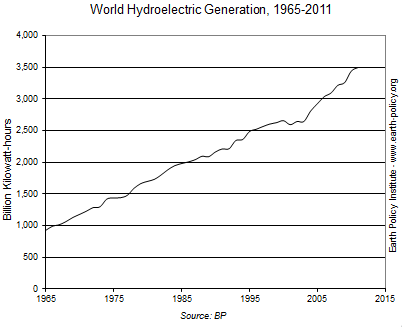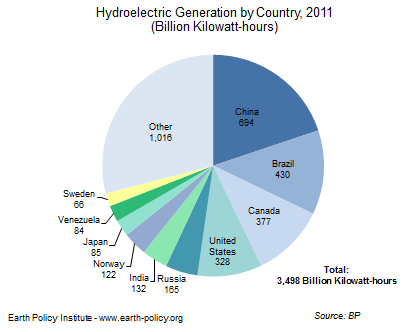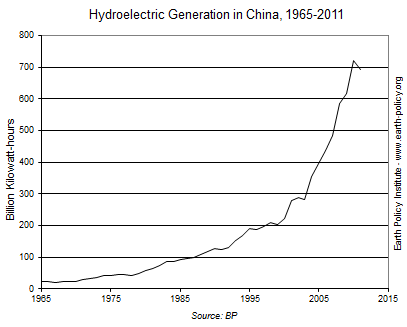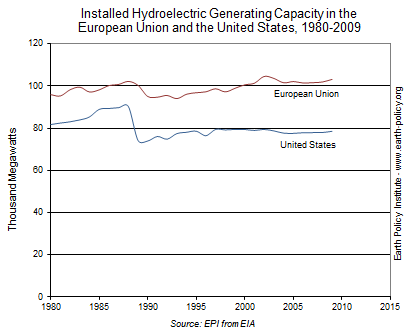By Hayley Moller
World hydroelectric power generation has risen steadily by an average 3 percent annually over the past four decades. In 2011, at 3,500 billion kilowatt-hours, hydroelectricity accounted for roughly 16 percent of global electricity generation, almost all produced by the world’s 45,000-plus large dams. Today hydropower is generated in over 160 countries.
Four countries dominate the hydropower landscape: China, Brazil, Canada, and the United States. Together they produce more than half of the world’s hydroelectricity.
Much of the world’s recent growth came from China, where hydropower generation more than tripled from 220 billion kilowatt-hours in 2000 to 720 billion in 2010. In 2011, despite a drop in generation due to drought, hydropower accounted for 15 percent of China’s total electricity generation.
Brazil, the second-largest producer of hydropower worldwide, gets 86 percent of its electricity from water resources. It is home to an estimated 450 dams, including the Itaipu Dam, which generates more electricity than any other hydropower facility in the world—over 92 billion kilowatt-hours per year.
Approximately 62 percent of Canada’s electricity is generated from its 475 hydroelectric plants. The country’s enormous hydropower capacity allows for electricity export; Canada sells some 50 billion kilowatt-hours to the United States every year—enough to power more than 4 million American homes.
Because most large dams in the United States were built before 1980, the country’s hydropower capacity has remained relatively stable in recent decades. The country’s highest capacity dam—the Grand Coulee Dam on the Columbia River in Washington State—was completed in 1942. Today, more than 7 percent of all U.S. electricity is supplied by hydropower. Similarly, hydropower in the European Union is relatively mature, with capacity increasing by less than one percent annually over the last 30 years. In 2011, hydropower supplied 9.5 percent of E.U. electricity generation.
Among the world’s largest producers, Norway gets the greatest share of its electricity from hydropower: a full 95 percent. Other countries that get the bulk of their electricity from river power include Paraguay (100 percent), Ethiopia (88 percent), and Venezuela (68 percent). A number of African and small Asian countries also generate virtually all of their electricity with hydropower, including Bhutan, the Democratic Republic of the Congo, Lesotho, Mozambique, Nepal, and Zambia.
While conventional hydropower will continue to grow as dams are completed in China, Brazil and a scattering of other countries, including Ethiopia, Malaysia, and Turkey, there exists enormous potential for non-conventional hydroelectricity generation from tidal and wave projects, as well as from small in-stream projects that will not require new dams.
Thus far, few of these hydrokinetic projects have been realized. France’s La Rance Tidal Barrage, with a 240-megawatt maximum capacity, was the first large tidal power plant. It began generating power in 1966, and is still operating today. In South Korea, a 254-megawatt project was completed in August 2011. Now the world’s largest tidal operation, it has the capacity to provide electricity for half a million people on the country’s west coast. New Zealand also recently approved a coastal hydropower project.
Wave power is also drawing the attention of both engineers and investors. Firms in France, Scotland, and Sweden, among other countries, are working to capture this emerging market. Estimates from the World Energy Council indicate that worldwide, wave energy has the potential to grow to a massive 10,000 gigawatts, more than double the world’s electricity-generating capacity from all sources today.
For additional data on the world’s energy resources, visit Earth Policy Institute’s Data Center and see the Supporting Data from World on the Edge by Lester R. Brown at www.earth-policy.org.
# # #
Media:
Reah Janise Kauffman
Email: rjk@earthpolicy.org
Tel: 202.496.9290 ext. 12
Research:
Janet Larsen
Email: jlarsen@earthpolicy.org
Tel: 202.496.9290 ext. 14
Earth Policy Institute
1350 Connecticut Avenue, NW
Suite 403
Washington, DC 20036
http://www.earth-policy.org





Recommended Comments
There are no comments to display.
Join the conversation
You can post now and register later. If you have an account, sign in now to post with your account.